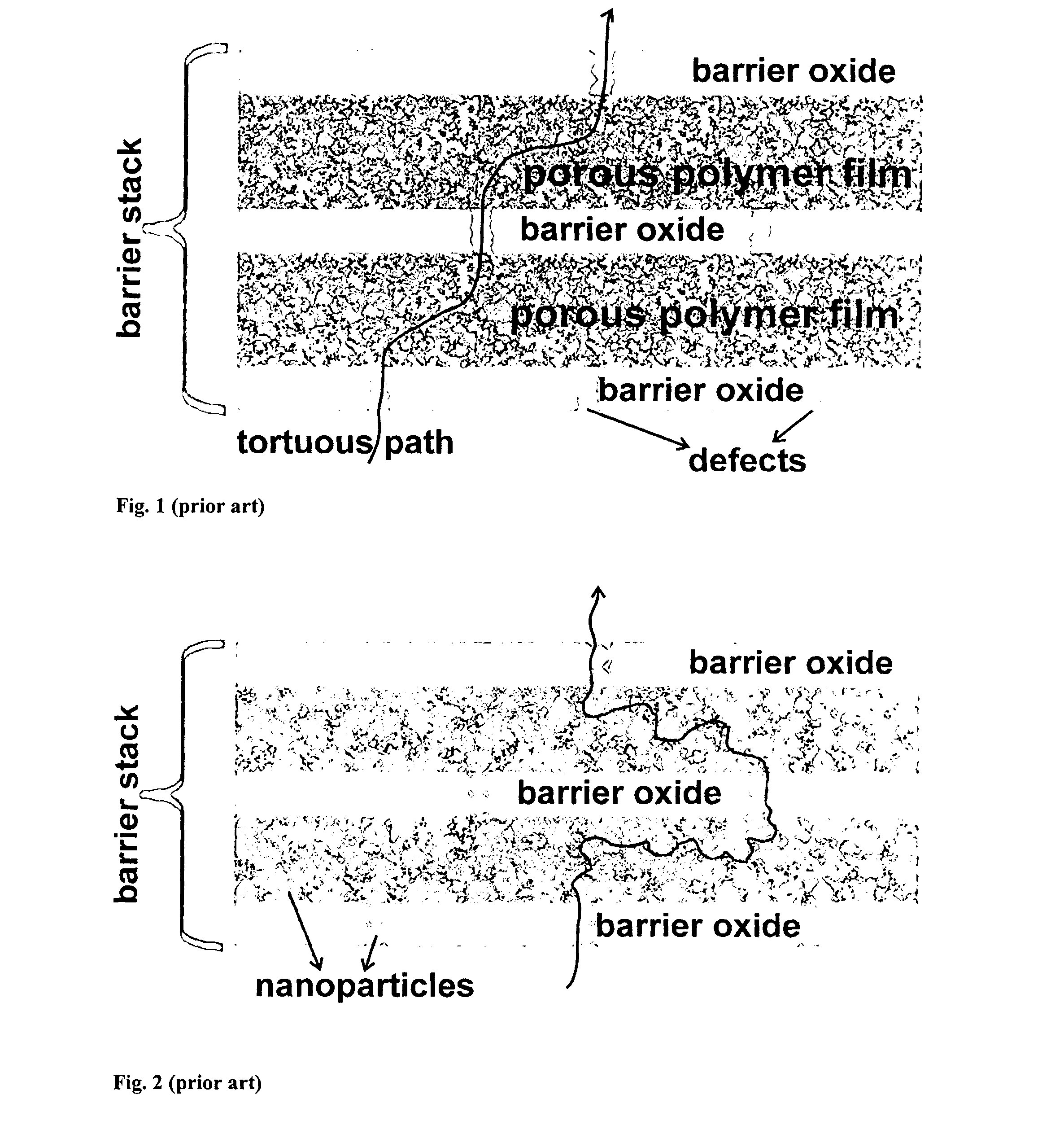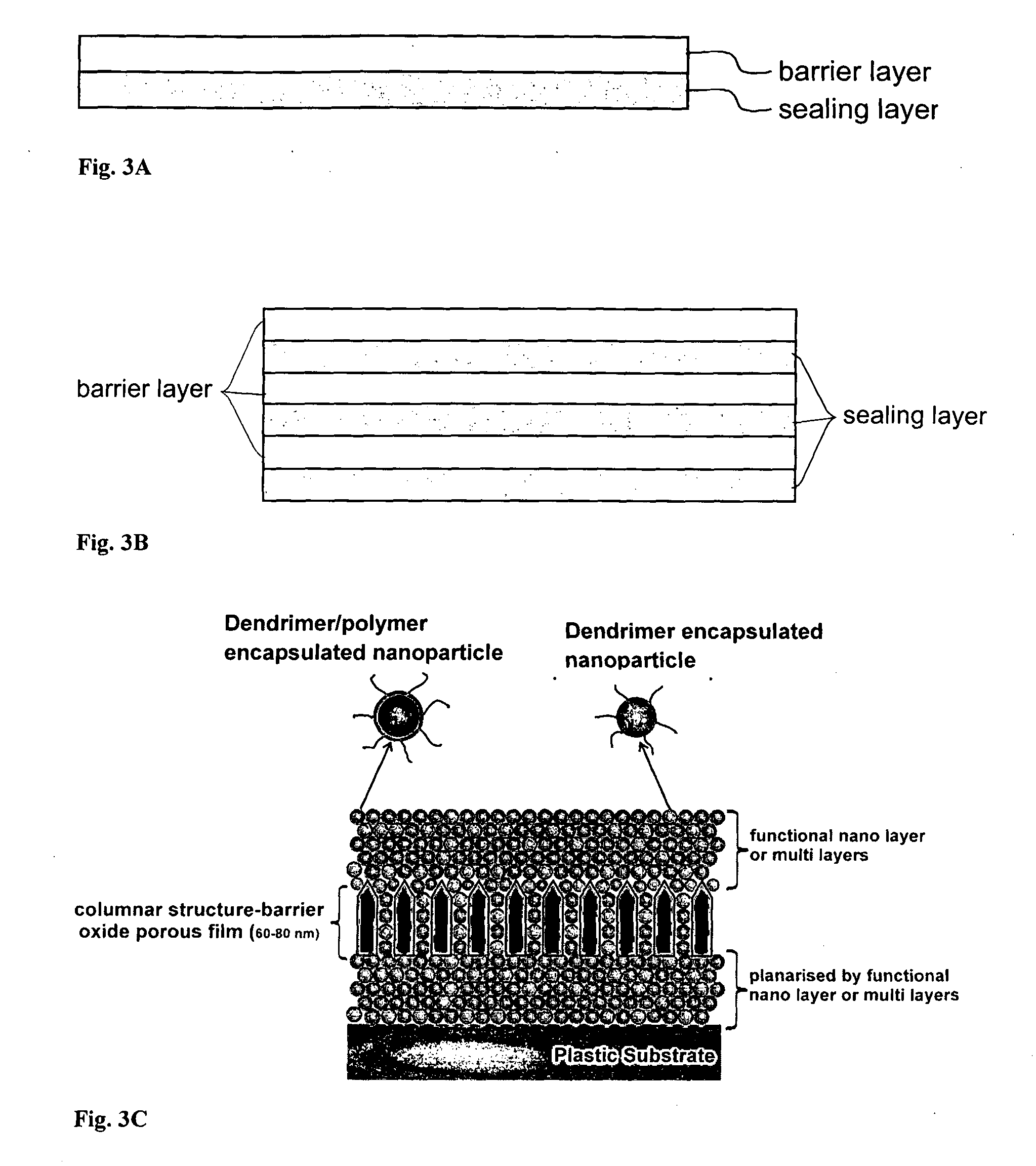Encapsulation barrier stack comprising dendrimer encapsulated nanop articles
a technology of dendrimer and nanop articles, which is applied in the field of encapsulation barrier stacks, can solve the problems of large affecting the performance of barrier films, the cost of polymeric substrates, and the performance of metal-oxide-coated polymer films, and achieves gas barriers, improved flexibility, and cost-effective effects
- Summary
- Abstract
- Description
- Claims
- Application Information
AI Technical Summary
Benefits of technology
Problems solved by technology
Method used
Image
Examples
embodiment 1
[0222]1. Plastic substrate—PET
[0223]2. Dendrimer encapsulated nanoparticle coating
[0224]3. SiN layer—CVD method
[0225]4. Dendrimer encapsulated nanoparticle coating
[0226]5. SiN layer—CVD method
[0227]Nano Solution Preparation:
[0228]The generation 5 PAMAM dendrimers, (2.3 g mixed with 20 ml of methanol) were obtained from Sigma Aldrich. The aluminum oxide nanoparticles “Aluminum oxide, NanoDur™ X1130PMA (50% by weight concentration in 1,2-propanediol monomethyl ether acetate, average particle size 45 nm according to the product bulletin of the supplier) were obtained from Alfa Aeser (a Johnson and Mathey Company). The solvents IPA:Ethylactate (5:15 ml ratio) were mixed and 3-Methacryloxypropyltrimethoxysilane (10 ml) added and then surfactant Dow corning FZ 2110 was further added by 0.5% by total weight of the solution and mixed. The UV curable acrylate monomer (Addision Clear Wave)—(3 ml) was then added to the above mixture for subsequent formation of a dendrimer / polymer encapsulated ...
embodiment 2
[0229]Nano Solution Preparation:
[0230]The generation 5 PAMAM dendrimers, (2.3 g mixed with 20 ml of methanol) were obtained from Sigma Aldrich. The aluminum oxide nanoparticles “Aluminum oxide, NanoDur™ X1130PMA (50% by weight concentration in 1,2-propanediol monomethyl ether acetate, average particle size 45 nm according to the product bulletin of the supplier) was obtained from Alfa Aeser (Johnson and Mathey Company). The solvents IPA:Ethyleactate (5:15 ml ratio) were mixed, and 3-Methacryloxypropyltrimethoxysilane (10 ml) added and then surfactant Dow corning FZ 2110 was further added by 0.5% by total weight of the solution and mixed. The UV curable acrylate monomer (Addision Clear Wave)—(3 ml) was then added to the above mixture for subsequent formation a dendrimer / polymer encapsulated nanoparticle. The mixture was kept in sonication for 2 hours. PAMAM dendrimers (2.3 g) was added to the mixture after sonication. The surface functionalized nanoparticle “Aluminum oxide, NanoDur™ ...
embodiment 3
[0231]The aluminum oxide nanoparticles (37% by weight concentration in 2-methoxypropyl acetate) were obtained from BYK Chemicals (NANOBYK 3610) and mixed with cyclohexanone in the ratio of 1:0.5 (60 ml). The cyclohexanone included 0.1% by weight of Dow 56 additive (obtained from Dow Corning). Then 3-methacryloxypropyltrimethoxysilane (5 ml) was added to the mixture and sonicated. After sonication, fourth generation (G4) poly(amidoamine) (PAMAM) dendrimers (1,2) 3 g mixed with 20 ml of methanol (obtained from Sigma Aldrich) was then added and further sonicated. 1,6-hexanediol ethoxylate diacrylate 5% by weight was added to the above mixture and sonicated for one hour. The above mixture was then spin coated and cured. The formulation was undertaken under inert gas environment. The set of experiments were carried out and spin coated onto the plain polymer substrate and barrier coated plastic substrates.
PUM
| Property | Measurement | Unit |
|---|---|---|
| size | aaaaa | aaaaa |
| thickness | aaaaa | aaaaa |
| thickness | aaaaa | aaaaa |
Abstract
Description
Claims
Application Information
 Login to View More
Login to View More - R&D
- Intellectual Property
- Life Sciences
- Materials
- Tech Scout
- Unparalleled Data Quality
- Higher Quality Content
- 60% Fewer Hallucinations
Browse by: Latest US Patents, China's latest patents, Technical Efficacy Thesaurus, Application Domain, Technology Topic, Popular Technical Reports.
© 2025 PatSnap. All rights reserved.Legal|Privacy policy|Modern Slavery Act Transparency Statement|Sitemap|About US| Contact US: help@patsnap.com



